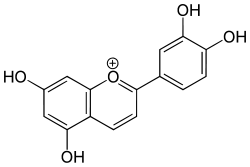Luteolinidin
Luteolinidin is a chemical compound belonging to the 3-deoxyanthocyanidins and that can be found in Sorghum bicolor.[1]
 | |
| Names | |
|---|---|
| IUPAC name
2-(3,4-dihydroxyphenyl)chromenylium-5,7-diol | |
| Other names
2-(3,4-dihydroxyphenyl)-5,7-dihydroxychromenylium 2-(3,4-Dihydroxy-phenyl)-5,7-dihydroxy-chromenylium | |
| Identifiers | |
3D model (JSmol) |
|
| ChemSpider | |
PubChem CID |
|
| UNII | |
CompTox Dashboard (EPA) |
|
| |
| |
| Properties | |
| C15H11O5+ | |
| Molar mass | 271.24 g/mol |
Except where otherwise noted, data are given for materials in their standard state (at 25 °C [77 °F], 100 kPa). | |
| Infobox references | |
Glycosides
Luteolinidin 5-O-β-D-[3-O-β-D-glucopyranosyl-2-O-acetylglucopyranoside] (a 3-Deoxyanthocyanidin laminaribioside) can be found in the fern Parablechnum novae-zelandiae (syn. Blechnum novae-zelandiae).[2]
gollark: =tex 3x^3-355x^2-2084x-2976 = 0
gollark: Er, that but equalling 0.
gollark: bee.
gollark: n apioforms are to be deployed, where n is the positive solution to $$3x^3-355x^2-2084x-2976$$.
gollark: Of course, it's possible I just made up the achievement thing's existence to make people do stupid stuff.
References
- Inclusions of flavonoid 3-deoxyanthocyanidins in Sorghum bicolor self-organize into spherical structures, Kirsten A. Nielsen, Charlotte H. Gotfredsen, Morten J. Buch-Pedersen, Henriette Ammitzbøll, Ole Mattsson, Jens Ø. Duus and Ralph L. Nicholson, Physiological and Molecular Plant Pathology, Volume 65, Issue 4, October 2004, Pages 187–196, doi:10.1016/j.pmpp.2005.02.001
- A Novel Acetylated 3-Deoxyanthocyanidin Laminaribioside from the Fern Blechnum novae-zelandiae, Ewald E. Swinny, 2000
This article is issued from Wikipedia. The text is licensed under Creative Commons - Attribution - Sharealike. Additional terms may apply for the media files.